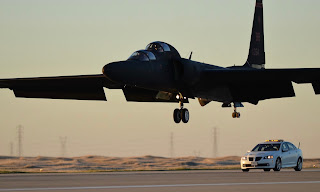Aircraft Machines
The Lockheed U-2, nicknamed "Dragon Lady", is an American single-jet engine, ultra-high altitude reconnaissance aircraft operated by the United States Air Force (USAF) and previously flown by the Central Intelligence Agency (CIA). It provides day and night, high-altitude (70,000 feet; 21,000 m), all-weather intelligence gathering.
Lockheed Corporation originally proposed it in 1953, approval followed 1954, and the first test flight occurred in 1955. It was flown during the Cold War over the Soviet Union, China, Vietnam, and Cuba. In 1960, Gary Powers was shot down in a CIA U-2A over the Soviet Union by a surface-to-air missile (SAM). Major Rudolf Anderson, Jr. was shot down in another U-2 during the Cuban Missile Crisis in 1962.
U-2s have also taken part in post–Cold War conflicts in Afghanistan and Iraq, and supported several multinational NATO operations. The U-2 has also been used for electronic sensor research, satellite calibration, scientific research, and communications purposes. The U-2 is one of a handful of aircraft types to have served the USAF for over 50 years, like the Boeing B-52. The newest models (TR-1, U-2R, U-2S) entered service in the 1980s with the latest model, the U-2S, receiving its technical upgrade in 2012.
U-2s have also taken part in post–Cold War conflicts in Afghanistan and Iraq, and supported several multinational NATO operations. The U-2 has also been used for electronic sensor research, satellite calibration, scientific research, and communications purposes. The U-2 is one of a handful of aircraft types to have served the USAF for over 50 years, like the Boeing B-52. The newest models (TR-1, U-2R, U-2S) entered service in the 1980s with the latest model, the U-2S, receiving its technical upgrade in 2012.
The design that gives the U-2 its remarkable performance also makes it a difficult aircraft to fly. Martin Knutson said that it "was the highest workload air plane I believe ever designed and built… you're wrestling with the airplane and operating the camera systems at all times", leaving no time to "worry about whether you're over Russia or you're flying over Southern California". The U-2 was designed and manufactured for minimum airframe weight, which results in an aircraft with little margin for error. Most aircraft were single-seat versions, with only five two-seat trainer versions known to exist. Early U-2 variants were powered by Pratt & Whitney J57 turbojet engines. The U-2C and TR-1A variants used the more powerful Pratt & Whitney J75 turbojet. The U-2S and TU-2S variants incorporated the more powerful General Electric F118 turbofan engine.
High aspect ratio wings give the U-2 glider-like characteristics, with an engine out glide ratio of about 23:1, comparable to gliders of the time. To maintain their operational ceiling of 70,000 feet (21,000 m), the early U-2A and U-2C models had to fly very near their never-exceed speed (VNE). The margin between that maximum speed and the stall speed at that altitude was only 10 knots (12 mph; 19 km/h). This narrow window is called the "coffin corner", because breaching either limit was likely to cause airflow separation at the wings or tail. For most of the time on a typical mission the U-2 was flying less than five knots (6 mph; 9 km/h) above stall speed. A stall would cause a loss of altitude, possibly leading to detection and overstress of the airframe. More details

